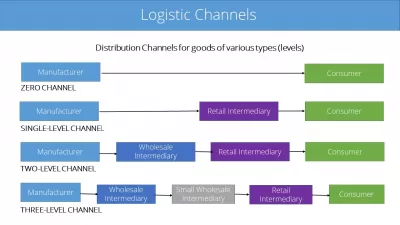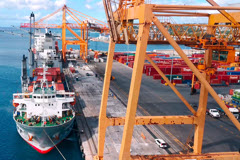What are Logistic Channels?
Logistic channels as an integral stage for business
In practice, along with the concept of a logistics chain, the term logistics channel is often used.
Traditionally, this concept is associated with a marketing channel (distribution or distribution channel), implying that physical distribution functions are implemented in the logistics channel.
A logistics channel (distribution channel, distribution channel, distribution channel) is defined as a partially ordered set consisting of a consumer, suppliers, intermediaries, carriers, insurers and other persons involved in the distribution of goods. In the same place, the chain is a “subset of the logistics channel”, that is, the fundamental difference lies in the level of aggregation of links in the chain and channel. It can be assumed that the channel is not a linearly ordered set of elements, since it has, for example, a layered (branching) structure.
Let us consider in more detail the structure and specifics of logistics channels.
Logistics distribution channels
It is a collection of organizations or individuals that assume or help transfer to other organizations and individuals the ownership of a particular good or service on the way from producer to consumer. The use of distribution channels brings certain benefits to manufacturers:
- financial savings for the distribution of products;
- the possibility of investing the saved funds in the main production;
- selling products in more efficient ways;
- high efficiency in ensuring the wide availability of goods and bringing it to target markets;
- reducing the volume of work on the distribution of products.
Thus, the decision on the choice of distribution channels is one of the most important, which must be taken by the management of the organization.
The channel of distribution is the path along which goods move from the producer to the consumer. The selected channels directly affect the speed, time, efficiency of movement and the safety of products when they are delivered from the manufacturer to the final consumer.
The organizations or individuals that make up the channel perform a number of important functions:
- carry out research work to collect information necessary for planning the distribution of products and services;
- stimulate sales by creating and disseminating information about products;
- establish contacts with potential buyers;
- adapt the product to the requirements of buyers;
- negotiating with potential consumers of products;
- organize goods circulation (transportation and warehousing);
- finance the movement of goods through the distribution channel;
- assume the risks associated with the operation of the channel.
All or part of these functions can be taken over by the manufacturer, while the costs of the manufacturer increase. Due to the specialization of intermediary organizations, they often perform the listed functions of goods distribution channels more efficiently. To cover their costs, intermediaries charge the manufacturer an additional fee. Thus, the question of who should perform the various functions of a distribution channel is a matter of relative efficiency. When it becomes possible to perform functions more effectively, the channel is rebuilt.
Logistics channel levels
Distribution logistics channels of goods can be characterized by the number of their constituent levels.
The channel layer is the intermediary that does the work of bringing the product and ownership closer to the end consumer. The length of the channel is determined by the number of intermediate levels between the producer and the consumer, which, like the levels of the channel, are members of the distribution channel.
Examples of distribution channels of various lengths are shown in the diagram.
The distribution channels shown in the figure are traditional channels. They consist of an independent manufacturer and one or more independent resellers. Each member of the channel is a separate enterprise, striving to secure maximum profit for itself.
The maximum possible profit of an individual channel member may be at the expense of the maximum profit extraction of the system as a whole, since none of the channel members has full or sufficient control over the activities of the other members. Such distribution channels are called horizontal.
Vertical distribution channels are channels made up of a manufacturer and one or more resellers acting as one unified system. One of the members of the channel, as a rule, either owns the other participating companies, or provides them with certain privileges. Such a member may be a manufacturer, wholesaler or retailer. Vertical channels originated as a means of controlling channel behavior. They are economical and exclude duplication of functions performed by channel members. When forming a distribution channel for goods, the decision on the structure of the channel, that is, on the number of channel levels and on the specific composition of the channel members, is put forward in the first place.
When identifying possible options for distribution channels, it is necessary to determine the type of intermediaries used.
Logistics Channels - distribution channels
The main goal of a logistics distribution system is to deliver goods to the right place at the right time. Unlike marketing, which deals with identifying and stimulating demand, logistics is designed to meet the demand generated by marketing at minimal cost.
Channel logistics can be viewed as an extension of the category of the logistics chain - it is a partially ordered set of all possible participants in a particular logistics process. Here, concreteness is primarily understood as the givenness of the source and final consumer of the flow.
Obviously, the solution of the problem of organizing distribution channels plays a major role in this. Due to the generality of the object of study, distribution logistics and marketing use the same concepts. This also applies to distribution channels.
Summarizing the above considerations, we will consider a logistics channel to be a separate set of elements oriented along the main flow, formulated in order to fulfill marketing requirements and save on the scale of logistics activities by harmonizing transactional units of packaging, storage, cargo processing and transportation of products.
Frequently Asked Questions
- How do logistic channels impact supply chain efficiency?
- Logistic channels play a crucial role in supply chain efficiency by determining the methods and pathways through which goods are transported from suppliers to end consumers, impacting delivery speed, cost, and overall supply chain reliability.

Freelancer, author, website creator, and SEO expert, Elena is also a tax specialist. She aims at making quality information available to the most, to help them improve both their personal and professional lives.

